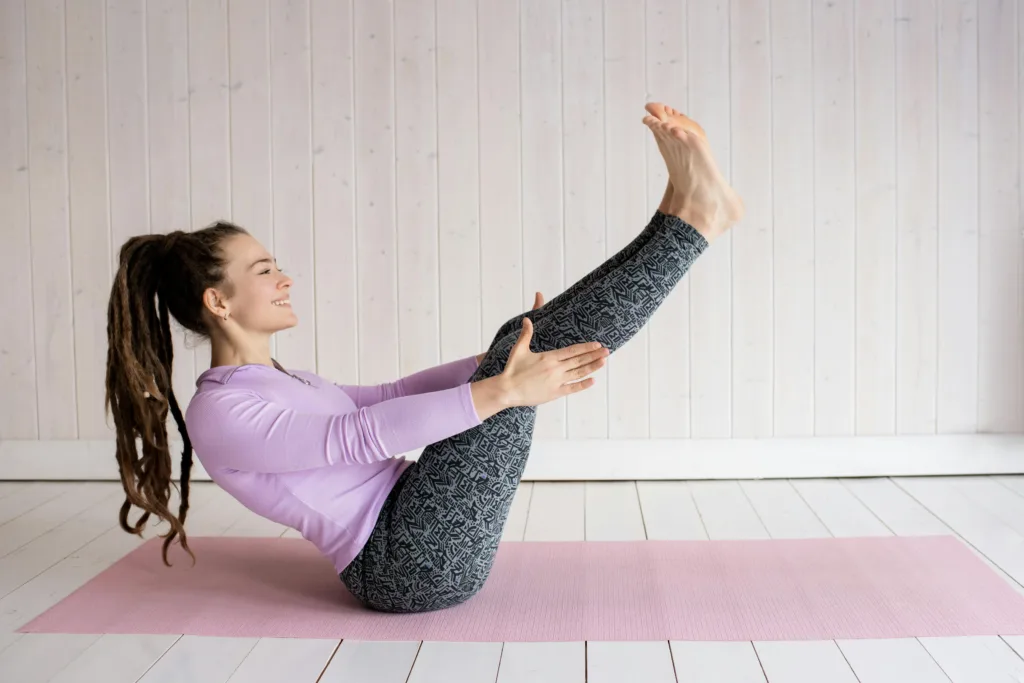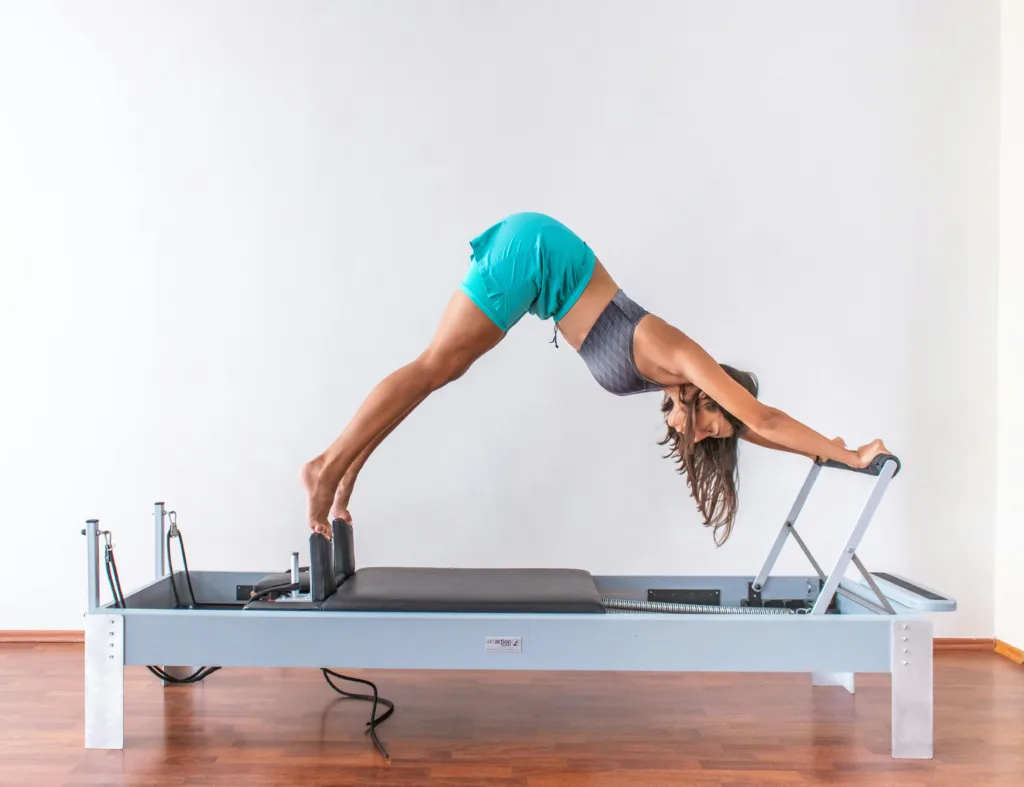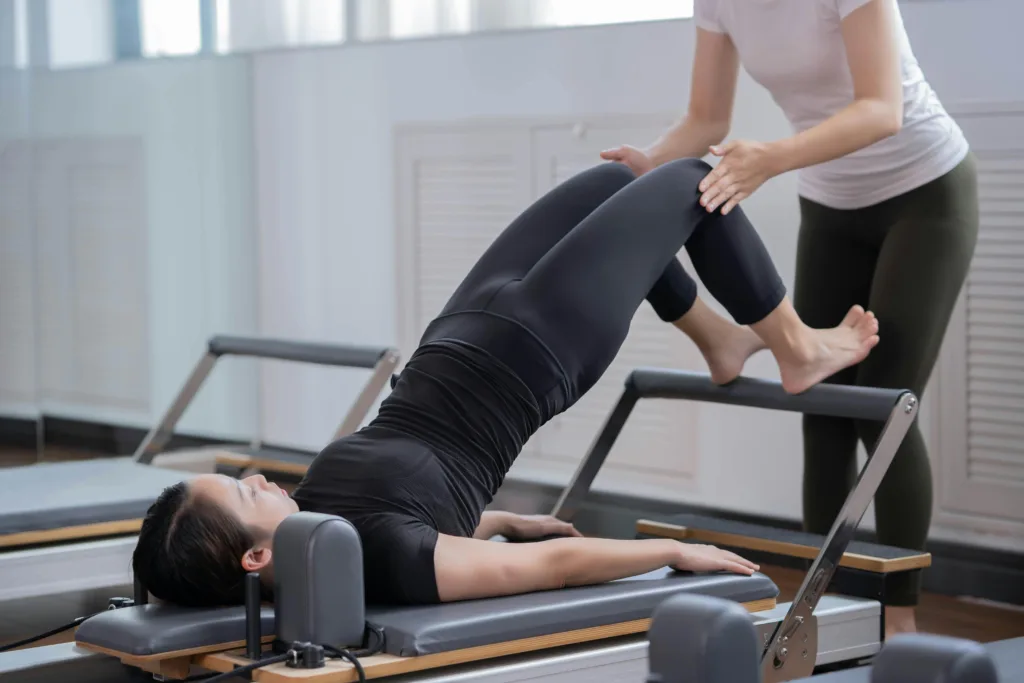Yoga & Pilates
Daily Pilates Benefits: Power of Consistency & Well-being
Did you know that daily Pilates practice can have a profound impact on your overall well-being? It’s not just about getting fit and toning your muscles; Pilates offers a holistic approach to fitness that combines physical and mental health benefits.

Are you a beginner or a seasoned fitness enthusiast? incorporating Pilates into your daily routine can bring about remarkable changes in your mind and body. From improved muscle strength and flexibility to reduced stress levels and enhanced body awareness, the power of consistency in Pilates practice is truly transformative.
Key Takeaways:
- Daily Pilates practice offers a multitude of physical and mental health benefits.
- The power of consistency lies in the regular practice of Pilates.
- Pilates improves muscle strength, flexibility, posture, balance, and coordination.
- It reduces stress levels and promotes a sense of body awareness.
- Incorporating Pilates into your daily routine can be tailored to your individual needs and goals.
Table of Contents
Understanding Pilates: Types and Principles
Pilates is a versatile exercise method that offers various types and principles to cater to different needs and preferences. Whether you prefer the classic approach, a contemporary twist, or a clinical focus, there is a Pilates style that aligns with your goals.
Types of Pilates
Pilates has evolved over the years, giving rise to seven main types:
- Classical Pilates: The original method developed by Joseph Pilates, emphasized precise movements and systematic exercises.
- Clinical Pilates: Designed for rehabilitation purposes, it focuses on targeted exercises to address specific injuries or conditions.
- Contemporary Pilates: Blending traditional Pilates principles with modern techniques, it offers dynamic and innovative workouts.
- Mat Pilates: A popular form that uses a mat as the primary equipment, focusing on bodyweight exercises and core strength.
- Reformer Pilates: Utilizes the Reformer apparatus to add resistance and challenge to Pilates movements.
- Stott Pilates: Incorporates contemporary principles and modifications to make Pilates accessible to a wider audience.
- Winsor Pilates: A Pilates style known for its focus on sculpting and toning the body through specific movements and sequences.
Each type of Pilates has unique characteristics and variations, providing a diverse range of options to suit different preferences and goals.
Principles of Pilates
Regardless of the type, Pilates is guided by a set of principles that form the foundation of the practice. These principles include:
- Core Strength: Emphasizing the activation and strengthening of the core muscles, which include the abdominals, back, and pelvic floor.
- Alignment: Focusing on proper alignment of the body to maintain optimal posture and prevent imbalances.
- Breath Control: Integrating mindful breathing techniques to enhance body awareness and promote relaxation.
- Precision: Performing each movement with precision and control to maximize effectiveness and prevent injury.
- Concentration: Engaging the mind to maintain focus and connect with the body during each Pilates exercise.
- Fluidity of Movement: Emphasizing smooth and flowing movements to enhance grace and efficiency.
The principles of Pilates contribute to the mind-body connection and promote overall well-being.
| Type of Pilates | Description |
|---|---|
| Classical Pilates | A Pilates style is known for its focus on sculpting and toning the body through specific movements and sequences. |
| Clinical Pilates | A specialized form of Pilates for rehabilitation purposes, tailored to address specific injuries or conditions. |
| Contemporary Pilates | A modern approach that blends traditional Pilates principles with innovative techniques, providing dynamic and challenging workouts. |
| Mat Pilates | A popular form of Pilates that utilizes a mat as the primary equipment, focusing on bodyweight exercises and core strength. |
| Reformer Pilates | Incorporates the use of the Reformer apparatus to add resistance and challenge to Pilates movements, enhancing strength and flexibility. |
| Stott Pilates | An approach that incorporates contemporary principles and modifications to make Pilates accessible to a wider audience. |
| Winsor Pilates | A Pilates style known for its focus on sculpting and toning the body through specific movements and sequences. |
Physical Benefits of Daily Pilates Practice

Regular Pilates practice brings numerous physical benefits that contribute to an overall healthy and strong body. By incorporating Pilates into your daily routine, you can experience improved muscle strength, balanced muscles, increased muscular control, enhanced flexibility, and improved posture.
Pilates is renowned for its ability to target and strengthen the core muscles, providing a solid foundation for movement and stability. With consistent practice, you will notice an improvement in your core strength, leading to a more balanced and stabilized body.
But Pilates doesn’t stop at the core. It helps restore balanced muscles throughout the body, ensuring all muscle groups work together harmoniously. This balanced muscle development not only improves physical performance but also reduces the risk of injuries caused by muscle imbalances.
Additionally, Pilates enhances muscular control, allowing you to have better command over your body’s movements. By focusing on proper alignment and engaging the correct muscles, you can develop heightened body awareness and control, leading to more efficient and controlled movements.
Pilates is also renowned for its ability to enhance flexibility. Through a combination of stretching and controlled movements, Pilates increases the range of motion in your joints, promoting supple and pliable muscles. Improved flexibility can help prevent injuries and contribute to better overall movement quality.
Lastly, Pilates promotes improved posture by targeting the postural muscles that support the spine and other body structures. By strengthening these muscles, Pilates helps correct imbalances and encourages proper alignment, resulting in improved posture and reduced strain on the spine.
With all these physical benefits combined, daily Pilates practice can help you achieve a leaner, stronger, and more balanced body, while also improving your overall movement quality and posture.
| Physical Benefits of Daily Pilates Practice | Description |
|---|---|
| Improved Muscle Strength | Pilates targets and strengthens the core muscles, leading to improved overall muscle strength throughout the body. |
| Balanced Muscles | By promoting balanced muscle development, Pilates helps restore symmetry and reduce the risk of injuries caused by muscle imbalances. |
| Increased Muscular Control | Through its focus on alignment and engagement of specific muscles, Pilates enhances your ability to control your body’s movements. |
| Enhanced Flexibility | Pilates incorporates stretching techniques that increase the range of motion in your joints, resulting in improved flexibility. |
| Improved Posture | Pilates strengthens the postural muscles, leading to better body alignment and improved posture. |
Mental Health Benefits of Daily Pilates Practice

In addition to the physical benefits, engaging in daily Pilates practice can have a profound impact on your mental well-being. Pilates offers a holistic approach to fitness, promoting a strong mind-body connection and fostering a sense of overall balance and harmony.
Lower Stress Levels
One of the key mental health benefits of Pilates is its ability to reduce stress levels. Through focused breathing techniques and mindful movement, Pilates helps you release tension and achieve a state of relaxation. By incorporating intentional breathing patterns, you gain control over your breath, which has a calming effect on your nervous system. Regular Pilates practice provides a much-needed break from the demands of daily life, allowing you to let go of stress and lower your anxiety levels.
Enhanced Body Awareness
Pilates cultivates a deep sense of body awareness, allowing you to better understand your physical sensations and emotions. Each movement in Pilates requires concentration and precision, leading to heightened mindfulness. As you become more attuned to your body, you develop a strong sense of proprioception and body alignment. This increased body awareness not only improves your physical performance but also fosters a deeper connection with yourself.
Decreased Anxiety and Depression
Studies have shown that regular Pilates practice can significantly decrease symptoms of anxiety and depression. The combination of physical movement, breath control, and mental focus creates a powerful therapeutic effect. Pilates helps release endorphins, or “feel-good” hormones, which naturally elevate your mood and reduce feelings of sadness or anxiety. The mind-body aspect of the practice also promotes a sense of inner calm and tranquility, providing relief from the symptoms of anxiety and depression.
Improved Cognitive Functioning
Pilates isn’t just beneficial for your physical health—it also has a positive impact on your cognitive functioning. Regular practice has been linked to improved memory, enhanced learning abilities, and sharper executive thinking skills. The mindful nature of Pilates requires concentration and mental engagement, which stimulates neural connections in the brain. This cognitive stimulation helps improve overall brain function and can have a lasting positive effect on your mental performance.
| Mental Health Benefits of Daily Pilates Practice |
|---|
| Lower stress levels |
| Enhanced body awareness |
| Decreased anxiety and depression |
| Improved cognitive functioning |
Pilates for Rehabilitation and Injury Prevention

When it comes to rehabilitating injuries and preventing future ones, Pilates is a highly effective form of exercise. Through its unique combination of stretching, strength training, and mind-body connection, Pilates helps strengthen the body in a balanced way, reducing the risk of injury and promoting overall well-being.
One of the key benefits of Pilates is improved balance and stability. By targeting the core muscles and focusing on alignment, Pilates enhances stability and coordination, making daily movements easier and safer. Whether you’re recovering from an injury or looking to prevent one, Pilates can help optimize balance and stability.
Individuals with specific injuries can modify Pilates exercises to suit their needs and promote healing. Working with a certified Pilates instructor is crucial during the rehabilitation process to ensure proper form and personalized exercises that address specific injury concerns. From modifications to targeted exercises, a certified instructor can provide expert guidance to aid in the rehabilitation process.
Now, let’s take a look at how Pilates can contribute to rehabilitating injuries, improving balance and stability, and decreasing the risk of future injuries.
| Benefits of Pilates for Rehabilitation and Injury Prevention |
|---|
| Rehabilitating Injuries |
| Improved Balance and Stability |
| Decreased Risk of Injury |
Rehabilitating Injuries
Pilates offers a gentle and controlled approach to rehabilitation, allowing individuals to rebuild strength and mobility gradually. With its emphasis on proper alignment and targeted muscle engagement, Pilates can aid in the recovery process for various injuries, such as back pain, joint issues, and muscular imbalances.
Improved Balance and Stability
Balance and stability are crucial for daily movements and activities, especially for individuals recovering from injuries. Pilates exercises focus on core stability and body alignment, which help improve balance and overall body control. By strengthening the core and promoting better posture, Pilates contributes to enhanced balance and stability.
Decreased Risk of Injury
Through strengthening the whole body and addressing muscle imbalances, Pilates reduces the risk of future injuries. By building a strong and stable foundation, individuals are better equipped to handle physical demands and maintain optimal joint and muscle function. Pilates also promotes body awareness, ensuring individuals can recognize and address potential injury triggers.
Incorporating Pilates into Your Daily Routine
If you’re looking to reap the benefits of Pilates on a daily basis, it’s important to create a sustainable routine that fits into your schedule. Varying the intensity and format of your Pilates workouts is key to prevent overexertion and injuries. This approach not only keeps your body challenged but also allows for proper recovery and repair.
Start by considering your fitness goals and preferences. Are you looking for a vigorous workout or a more gentle session? Do you prefer working out at home or in a studio environment? Evaluating these factors will help you determine the best approach to incorporate Pilates into your daily routine.
It’s recommended to have rest days throughout the week to give your body time to rest and rejuvenate. These rest days are crucial for muscle recovery and overall well-being. Plan your Pilates schedule accordingly, ensuring you have days where you engage in other activities or simply relax.
Thanks to the accessibility of online Pilates classes, integrating Pilates into your daily routine has never been easier. Online classes provide flexibility in terms of time and location, allowing you to practice Pilates whenever and wherever suits you best. They also offer a wide range of classes catering to varying levels of experience and intensity.
Consulting with a certified Pilates instructor can further enhance your practice. They can help you design a personalized program tailored to your fitness goals and ensure proper alignment and technique. Whether you’re a beginner or an experienced practitioner, working with an instructor can provide valuable guidance and support.
Tips for Incorporating Pilates into Your Daily Routine
- Start with short Pilates sessions and gradually increase the duration over time.
- Experiment with different types of Pilates, such as mat or reformer workouts, to keep your routine interesting and challenging.
- Set realistic goals and track your progress to stay motivated and engaged.
- Find a dedicated space in your home where you can practice Pilates comfortably.
- Consider incorporating Pilates into your warm-up or cool-down routine for other physical activities.
| Benefits of Incorporating Pilates into Your Daily Routine |
|---|
| 1. Improved core strength |
| 2. Increased flexibility |
| 3. Better posture and alignment |
| 4. Enhanced body awareness |
| 5. Reduced stress levels |
| 6. Injury prevention |
Conclusion
Daily Pilates practice offers a multitude of benefits for both your mind and body. The power of consistency lies in incorporating Pilates into your daily routine, allowing you to experience improved core strength, flexibility, posture, balance, and coordination. By dedicating time to this versatile exercise method, you can effectively enhance your overall well-being and reduce stress levels.
In addition to the physical advantages, Pilates promotes a strong mind-body connection, increasing your sense of body awareness. This heightened awareness allows you to better understand your physical sensations and emotions, contributing to a greater sense of well-being.
Regardless of your fitness level and goals, Pilates can be customized to suit your individual needs. Its accessibility makes it an excellent option for people of all ages and abilities. So, why wait? Start reaping the daily Pilates benefits and unlock the transformative power of consistency for your well-being today.
FAQ
What is Pilates?
Pilates is a form of exercise that combines stretching, strength training, and mind-body connection. It was developed over 100 years ago by Joseph Pilates and aims to provide benefits for both the mind and body.
How many types of Pilates are there?
There are seven types of Pilates, including classical, clinical, contemporary, mat, reformer, Stott, and Winsor Pilates. Each type has its own characteristics and variations.
What are the principles of Pilates?
The principles of Pilates include focusing on core strength, alignment, breath control, precision, concentration, and fluidity of movement.
What are the physical benefits of daily Pilates practice?
Regular Pilates practice improves muscle strength, particularly in the core area, restores balanced muscles throughout the body, enhances muscular control, improves flexibility, and promotes better posture by strengthening the postural muscles and encouraging proper alignment of the spine.
What are the mental health benefits of daily Pilates practice?
Daily Pilates practice reduces stress levels through focused breathing and mind-body connection, enhances body awareness, decreases anxiety and depression symptoms, and improves cognitive functioning, including memory, learning, and executive thinking.
Can Pilates be beneficial for rehabilitation and injury prevention?
Yes, Pilates can be an effective form of exercise for rehabilitation and injury prevention. It helps strengthen the body in a balanced way, improves balance and stability, and reduces the risk of future injuries. Pilates can also be modified to suit individual needs for promoting healing.
How can I incorporate Pilates into my daily routine?
You can incorporate Pilates into your daily routine by practicing it regularly, varying the intensity and format of the workouts, and ensuring you have rest days to allow the body to recover and repair. Online Pilates classes can provide convenient options, and consulting with a certified Pilates instructor can help design a personalized program with proper alignment and technique.



